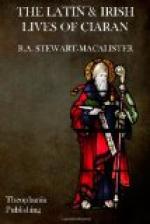The Resistance of the Saint to amorous Advances.—The reader may be referred to Whitley Stokes’s note ad loc., in LL. We may recall the well-known story of Coemgen (Kevin) at Glendaloch: though it must be added that the version of the tale popularised by Moore, in which the saint pushed his importunate pursuer into the lake and drowned her, has no ancient authority. On the rather delicate subject of the arrangement made between Ciaran and the maiden’s family, consult the article Subintroductae in Smith and Cheetham’s Dictionary of Christian Antiquities. This feature of the story is enough to show its unhistorical character, at least so far as Ciaran is concerned: for Ciaran did not belong to the Primus Ordo of Irish saints, who mulierum administrationem et consortia non respuebant, quia super petram Christum fundati ventum temptationis non timebant, but to the Secundus Ordo, who mulierum consortia et administrationes fugiebant, atque a monasteriis suis eas excludebant (CS, 161, 162). The description of Ciaran as transcending his contemporaries in beauty is probably suggested by Ps. xlv, 2, and is another illustration of the Tendenz already referred to.
The Eavesdropper and the Crane.—This incident reappears in the Life of Flannan (CS, 647). Wonder-workers do not like to be spied upon by unauthorised persons. This is especially true in the Fairy mythology surviving to modern times. Compare a tale in the Life of Aed (VSH, ii, 308). A quantity of wood had been cut for building a church, but there was no available labour. Angels undertook the work of transportation on condition that no one should spy upon them. One man, however, played the inevitable “Peeping Tom,” and the work ceased immediately. The reader may be referred for further instances to the essay on “Fairy Births and Human Midwives” in E.S. Hartland’s Science of Fairy Tales.
There is a touch of intentional drollery at the end of the story where the brethren are shown as having so thoroughly enjoyed the feast miraculously provided for them that their observance of the canonical hours was disjointed. For other instances of intoxication as resulting from saints’ miracles see VSH, i, p. ci.
The Stanzas in VG.—These are in ae freslige metre, so that they are probably another fragment of the poem already met with. The translation in the text reproduces the sense with sufficient literalness.
On the whole the impression which this unusually long and very confused incident makes on the reader is that originally it was an anti-Christian narrative concocted in a Pagan circle, which has somehow become superficially Christianised.




